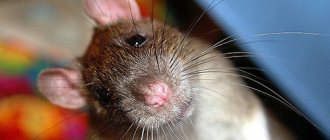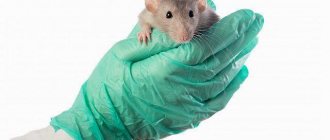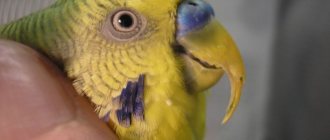What diseases of domestic rats are dangerous for these animals. Pets come in all different shapes and sizes. Among them are rodents: hamsters, chinchillas and, of course, rats. Caring for rats requires not just ordinary knowledge of keeping them, but also specific conditions for keeping and caring for them. It is important to consider the cage, food, bedding and many other factors that affect the health and immunity of the animal.
It is important not to diagnose and treat yourself ; this will have a bad effect on the health of the rodent, which is already susceptible to disease. Traditional medicine is not the best way to rid your pet of pathology and abnormalities. It is better to entrust this matter to a professional veterinarian who knows how to treat the disease. At the veterinary office, an experienced expert is ready to respond to a call within an hour at a time that the owner chooses. The veterinarian also has all the necessary tools and papers with him, which means he will conduct diagnostics and tests upon arrival .
In this article we will look at the basic methods of keeping rats, diagnostics, rat diseases and their treatment.
Diseases of domestic rats: keeping and caring for a rat
As already mentioned, keeping and caring for a rat includes knowing how to choose the right cage, bedding and food wisely. The cage must be of suitable size, it must have several floors and space to run around. Instead of a cage, you cannot use various aquariums and homemade products. It is also worth considering the presence of a running wheel and a house. in which she can build a nest and sleep. It is also worth remembering that rats love to mark their territory, which is accompanied by a strong odor, so you should clean the cage and change the bedding every day . If you have increased sensitivity to odors, then you should take a closer look at more sterile and hypoallergenic rodents.
It is worth noting that sometimes the rodent is kept outside the cage , at the level of other pets. He also has a corner where he lives. It consists of a bowl, a drinking bowl and a bed, possibly a wheel. Such cases are rare and are not recommended for the safety of the animal and to prevent it from chewing the wire from the TV or otherwise causing mischief. It is impossible to toilet train rodents.
There are special fillers for cages , and there are also regular sawdust. It is worth trying several options to see which one is most suitable for your rat. After all, they all have specific tastes and individual characteristics. Also, an allergic reaction develops to some types of bedding.
With food, you should take the same conditions, choose an optional food that the animal will like . It should contain the necessary vitamins and minerals for healthy immunity and strength. It is worth diluting the food with organic and natural food , and in summer and spring give clean and washed grass as food.
It is worth considering the main characteristics of the rodent and the features of its maintenance:
- The body of a domestic rat can reach twenty-five centimeters.
- A rat weighs up to half a kilogram, and females are always smaller in size than males.
- Lifespan varies, some say that a rat can live for more than four years, while others say it only lives for three years. There is a recorded case where a rat lived for seven years and four months.
- The color of the coat varies from snow-white to black.
- It is worth noting once again that rats are predators, so they should be fed boiled meat. They should also always have access to clean drinking water.
- You should not place the cage on a window, because drafts and sunlight will have a bad effect on the health of the animals and their life expectancy.
- The food must be selected according to the specific personality of the animal. You need to let them try different types of food and then draw a conclusion. In general, such an experiment can last for a month. You can ask your veterinarian for advice, who will definitely tell you which food is best to use and what food should be diluted with it.
What does a sick animal look like?
Signs of the disease depend on the affected organ.
The rat/mouse may experience
- apathy/aggression;
- sticky or disheveled, like greasy wool;
- change in behavior (refusal of food, fear of hydrophobia, constant scratching, torticollis, a rat may seek human company and obediently accept affection for a long time);
- the appearance of rashes, ulcers, bald patches on the skin;
- swollen/sour or cloudy eyes;
- the animal’s nose may be covered with a scab and wet;
- the back is arched and tense;
- teeth or claws are too long.
For example, cardiac pathology is characterized by the animal falling to one side and a feeling of lack of air, as a result of which the animal gasps for air. Kidney diseases are characterized by disturbances in urination in the direction of increased frequency and changes in the quality characteristics of urine (turbidity, blood, unpleasant odor). Skin diseases are characterized by itching and deterioration of coat quality. Respiratory ailments are accompanied by hoarse and shallow breathing, impaired nasal breathing and constant moistening of the animal's fur around the face with nasal secretions.
Rat Intelligence
Not everyone believes, but rats are quite smart creatures. They are even trainable and are taught to do various elements and obey commands. If you work with an animal for a long time and reward it with treats, it can learn a lot, for example:
- Find out your nickname and respond to it.
- Stand on your hind legs and obey such commands.
- Go to the cage or bedding on command.
- Do different tricks and jumps, pretend to be dead and so on.
Training an animal is not that difficult, it just requires skill and time. For example, after the animal’s name is heard, it is given a treat. Helped complete the element - the rat gets food. And so on with all the tricks that the owner wants to teach the animal. It is worth considering that their memory is not the best, so the nickname should be short, and it is also worth practicing all the tricks that she can forget after a month of life. After all, for domestic rats, a month is like a human year .
It is very important at such moments to show affection and care. The rat should live with the owner for some time, after which it will feel safe and cared for. It’s also worth choosing healthy treats, which your veterinarian can help you decide on.
Dangerous infections for humans
Diseases that a rat or mouse can “share” with a person are infectious. Most often, wild animals are carriers of diseases dangerous to humans. But there is still some risk of infection of the pet and its owner
Diseases dangerous to humans are:
- pneumonia in rats caused by mycoplasma;
- rodent rabies;
- typhus;
- plague;
- tularemia;
- toxoplasmosis;
- sodoku (rat bite disease);
- leptospirosis;
- rickettsial diseases;
- hemorrhagic fever;
- listeriosis;
- toxocariasis (helminthic infestation);
- fungal infections (trichophytosis and microsporia).
Pasteurellosis and lymphocytic choriomeningitis pose a relative danger to humans. A person can become infected through direct contact with a rodent, the bite of a pet, the bite of a parasite that lives on the animal’s skin, and if the animal likes to stick its muzzle into the owner’s plate and bite into various goodies (by food). There is a risk of infection through airborne droplets.
Diseases of domestic rats: diet of a decorative rat
The diet of a decorative rat does not differ much from the diet of any predator. Otherwise, we can say that rats eat almost everything that is given to them. However, you should limit smoked, fatty, fried and, of course, sweet and salty foods. This will affect their gastrointestinal tract in a negative way and gastrointestinal diseases cannot be avoided.
It is also worth giving up the following products: bread and anything related to flour, sausages, fruits or vegetables that have already become overripe or, on the contrary, underripe; do not feed radishes, raw potatoes, beets or cabbage. Animals will happily eat all of the above, but if the owner wants his pet to live as long a life as possible and be happy for as long as possible, it is worth giving up these products. In principle, this applies to all animals that live at home.
To prevent a decorative rat from having an upset stomach and its health from deteriorating, it is worth feeding the following foods:
- Cereals such as oats, barley and so on.
- Ripe fruits, especially apples and the like.
- Ripe vegetables and cucumbers are especially good.
- It is worth giving fish, preferably once a week.
- Dairy products, of course the most important thing are milk and cheese.
- In summer, it is worth picking herbs and clover, washing and drying them thoroughly and giving them only after that.
- Specialized feeds that are already prepared and contain a lot of nutrients and minerals. However, you should not dwell only on them and feed only food from the store. There must be a proper balance of food products.
The domestic rat itself must be fed several times a day , it does not matter whether it is morning or night, the main thing is that it is always the same time. It is important to provide constant access to the drinking bowl and change the water in it every day so that it does not stagnate and does not collect a large number of parasites. If the little rat is very small, then you should feed it four times.
A mineral stone is always placed in the cage of a decorative rat, on which the rats sharpen their teeth and clean them. Thanks to this, you can even let them go for a walk around the apartment or house, because they will not touch the wires after they have sharpened them. This method also helps saturate their body with useful calcium.
It is always worth keeping in mind that rats get fat quickly and are prone to obesity. This means that you cannot overfeed them. Goodies from the common table are extremely rarely allowed. There should also be access either to a walk around the apartment (they need to be walked almost like dogs) or access to a wheel in which the rat can run and dispel accumulated fat.
Domestic rats are active and love an active lifestyle , but for this they need to be helped and not fed. In just a couple of months, the pet will gain weight to a large size, and this, obviously, will negatively affect its lifespan and the number of years it will delight its owners.
Ask yourself: “Is your pet healthy?”
Balanced diet. Rats should have a nutritious and balanced diet. They should not be given fatty foods. Do you feed your rat the foods it needs for proper development: fresh fruits, vegetables, seeds, grains? Does she have fresh water?
Correct content. The rat cage should always be clean. The house must be dry. The cage should be placed away from direct sunlight or air conditioning. It should not be in a smoky room. Are you keeping your pet correctly?
Regular examination of the animal. Your pet should have his ears, teeth and eyes examined regularly. Do you conduct such medical examinations?
If you find an error, please select a piece of text and press Ctrl+Enter.
The domestic rat and its diseases
Even such a small animal as a rat has many diseases. They have common symptoms of appearance, which are not so difficult to notice. The typical rodent is always active, with shiny eyes, soft, pleasant fur, its ears and nose are clean, its nose is slightly wet, and there is no redness anywhere. If this condition changes, you should immediately call a veterinarian at home. Just call, because an extra trip can aggravate the situation . The immune system is weakened, which means the infection can enter the body much more easily and secondary infection will occur. Excess stress can affect the immune system even more.
Next is a list of diseases that domestic rats can suffer from. Not to say that there are a lot of them, but the rodent’s body is quite fragile in itself, so the treatment is specific and can only be entrusted to an experienced veterinarian.
Diseases of domestic rats: Mycoplasmosis
The disease is caused by a bacterium called Mycoplasma pulmonis. Moreover, most rats are carriers of the disease, but those who come into contact with a relative sick with mycoplasmosis become ill. Another reason may be weak immunity or the age of the rat, if it is three years old or older.
The signs of the disease mycoplasmosis are as follows: wheezing, discharge appears from the nose that was not there before, it looks like blood, the rat sneezes and attacks of suffocation appear.
The disease affects the rat's lungs; if it is a female rat, there is a risk of infection in the uterus. If the disease was detected early and the owner took the time to call the veterinarian, then the disease passes quickly and does not have strong consequences. If at later stages, then antibiotics and strong drugs are used, recovery and prevention after which is much longer and higher.
At the age of three years and above, no veterinarian can guarantee a complete recovery. However, they can determine a course of treatment and stick to it in order to achieve results that the owner could not achieve.
Diseases of domestic rats: Listeriosis
Listeriosis is a disease that is dangerous for humans as well. A person becomes infected after contact with a rat or through objects with which the animal has been in contact. It is not so important whether it is food or bedding for your pet. It’s not for nothing that they say that rats are carriers of diseases. Domestic rats can also spread this disease.
Signs of listeriosis are not difficult to see: the animal stops eating, its body temperature rises, and it loses coordination in space. The females have damage to the uterus and will not be able to bear offspring.
There is an acute phase of listeriosis , in which the veterinarian will not be able to help in any way, because death occurs literally within two to three days. It is worth saying that sometimes the symptoms are not visible at all, but the disease is there. Only a veterinarian and his tests can confirm the diagnosis of the disease.
Treatment is very rare; most often the animal is simply placed in a quarantine zone and they try to do everything possible, but most often it dies. A dead animal should be disposed of as soon as possible, because it is extremely dangerous to human health.
Diseases of domestic rats: Ectromelia or rodent pox
Ectromelia or rodent pox - there is an acute form and a chronic one. During acute extromelia, the disease is asymptomatic and extremely rapid; the animal dies within a couple of days. Chronic rodent smallpox manifests itself in that the skin and muscles are affected. The cause and cause is a virus that exists in the skin, spleen, liver and some other organs.
The skin is susceptible to ulcers and swelling. When chronic, the disease lasts several months, but if it is cured by the competent actions of a veterinarian, the rat acquires immunity for all subsequent years of life.
It is worth disinfecting all surfaces that the animal touches, and also spend several days in quarantine. Quarantine sometimes reaches thirty days, it all depends on what the doctor says. If the pet dies, then the body should be burned or disposed of in a similar way without harm to surrounding people and animals. After all, they may become infected as well.
Diseases of domestic rats: Infectious diseases
Even pet rats and rodents are exposed to infectious diseases, viral diseases and also common microbes. The virus enters the body through water, food or the hands of the owner. In general, symptoms can vary greatly, but if the slightest deviation from the norm is noticed, it is worth calling a veterinarian at home from the Ya-Vet clinic. An experienced expert will conduct a competent diagnosis, take tests and receive their results immediately. Within half an hour, a course of treatment will be prescribed, which will determine the fate of the animal. If you follow the instructions, your pet will “get back on its feet” very quickly.
Treating your pet yourself is not the best idea. The owner only needs to recognize the disease and call help at home. And then follow the instructions. This is done for the benefit of not only the animal, but also the owner. After all, there is a risk that the rodent’s condition will worsen, a secondary infection will occur, which is dangerous for humans, and then the whole family will have to be treated.
Diseases of domestic rats: Salmonellosis
Salmonellosis is a common disease in summer, early autumn and late spring. The disease itself enters through food or water, and then spreads its effect through feces and urine. Acute illness is accompanied by diseases of the gastrointestinal tract, this is visible through the specific color of stool and its smell. The rat becomes larger due to the gases accumulated inside.
Salmonellosis is prevented by disinfection and boiling, which kills the parasites.
The rat itself should be killed and the body disposed of by burning, and those who have been in contact with it for a long time should be quarantined for a month.
Other types of disease in domestic rats:
- Long incisors. A mineral stone in a cage, which was already mentioned above, can help deal with them.
- The eyes and nose become red, most often due to allergies. It is worth identifying the allergen and getting rid of it. A veterinarian can help identify the allergen.
- Bleeding from the genitals, which occurs due to a tumor or infection of the entire urinary system. A veterinarian will determine the diagnosis more accurately.
- Don't forget about fleas and other small parasites that live on rodents no less often than on larger pets.
Rat tumors
Just like in humans, tumors in rodents can be malignant or benign. Their appearance is largely due to genetics, that is, the personal predisposition of each individual rat to tumor formations. In addition, the diet and lifestyle of the rat certainly influences. An animal that leads an active life and receives proper, balanced nutrition is less susceptible to the development of tumors in the body.
Only a qualified rodent veterinarian called to your home will be able to determine the type of tumor. He will also be able to prescribe treatment, although in the case of a malignant tumor one can hardly hope for a long life for a pet.
Diseases of domestic rats: What to do if a rat gets sick?
If a rat gets sick, first of all you should put your emotions aside and remember that diseases of rats in most cases are extremely dangerous, including for people. Therefore, if the veterinarian talks about euthanizing and disposing of the pet’s body, you should listen to him. After all, there is a risk of putting the whole family at risk; treatment of some viruses and infections will be expensive. After all, everyone knows that rats spread diseases. And it doesn’t matter that these are decorative rats. If there is another pet in the house, then such actions are even more necessary.
The infection itself occurs through the mucous membrane or through the blood after insect bites. Therefore, if you suspect a disease, you should contact a veterinarian at the Ya-Vet clinic .
It is worth maintaining personal hygiene as well . Protect the animal, do not allow the rat near larger pets if there is a suspicion that they are sick or if they have returned from a walk and have not washed themselves. After all, on the hands or fur of other animals there is a risk of bringing an infection that will fall on the food or bedding, which means it will enter the body of a rodent, whose immunity and body are already fragile.
It is worth keeping in mind that self-medication in this case is not an option. Traditional medicine will not help, but will only aggravate the situation or hasten the death of the pet. An extra few words should be said about water procedures, which are so important in caring for rats and rodents.
Decorative rats swim from birth and love bathing. It is allowed to bathe rats every other day, but not more often. The water should be regulated and ensured that it is clean and warm. Use specialized shampoos for rodents. After bathing, the animal should be dried and allowed to dry, but not in a draft.
Infectious diseases
Diseases that belong to this group can be transmitted through air, food, drink, contact and insect bites.
The most common infectious diseases include:
- pneumonia;
- scabies;
- mycoplasmosis;
- tuberculosis.
The recovery statistics are very sad. Only 10% of sick animals recover.
It should be noted that there is a high probability of transmitting an infectious disease to the pet owner. Therefore, if you have a pet rodent in your home, you need to have an idea about such dangerous ailments.
Traumatic lesions
This group includes burns, fractures, wounds, cuts, and bites. Small rodents may have pododermatitis or painful heels.
Burns
May occur when exposed to flames, hot liquids and aggressive chemicals. Severe burns lead to tissue necrosis and death of the animal.
Fractures
The bones of the extremities are most often affected. This occurs as a result of a bruise, the release of a limb that is pinched by something, the growth of claws, or a sharp muscle contraction. The likelihood of a fracture is higher if the animal suffers from osteomalacia, a lack of vitamins.
Scratches and bites
When keeping several animals in one cage, the owner must be prepared for wounds and bites on the pets. Rats can fight over food, out of boredom, and for a number of other reasons. Wounds must be treated immediately, otherwise they will become infected.
Pododermatitis
The disease is usually traumatic in nature and is caused by an uneven cage floor and frequent running of the rat/mouse on a hard floor. Obesity and physical inactivity contribute to the development of the disease. The disease manifests itself as hair loss in the heel area and the appearance of inflamed areas in these places. Sometimes even the tendons of the foot are affected.











